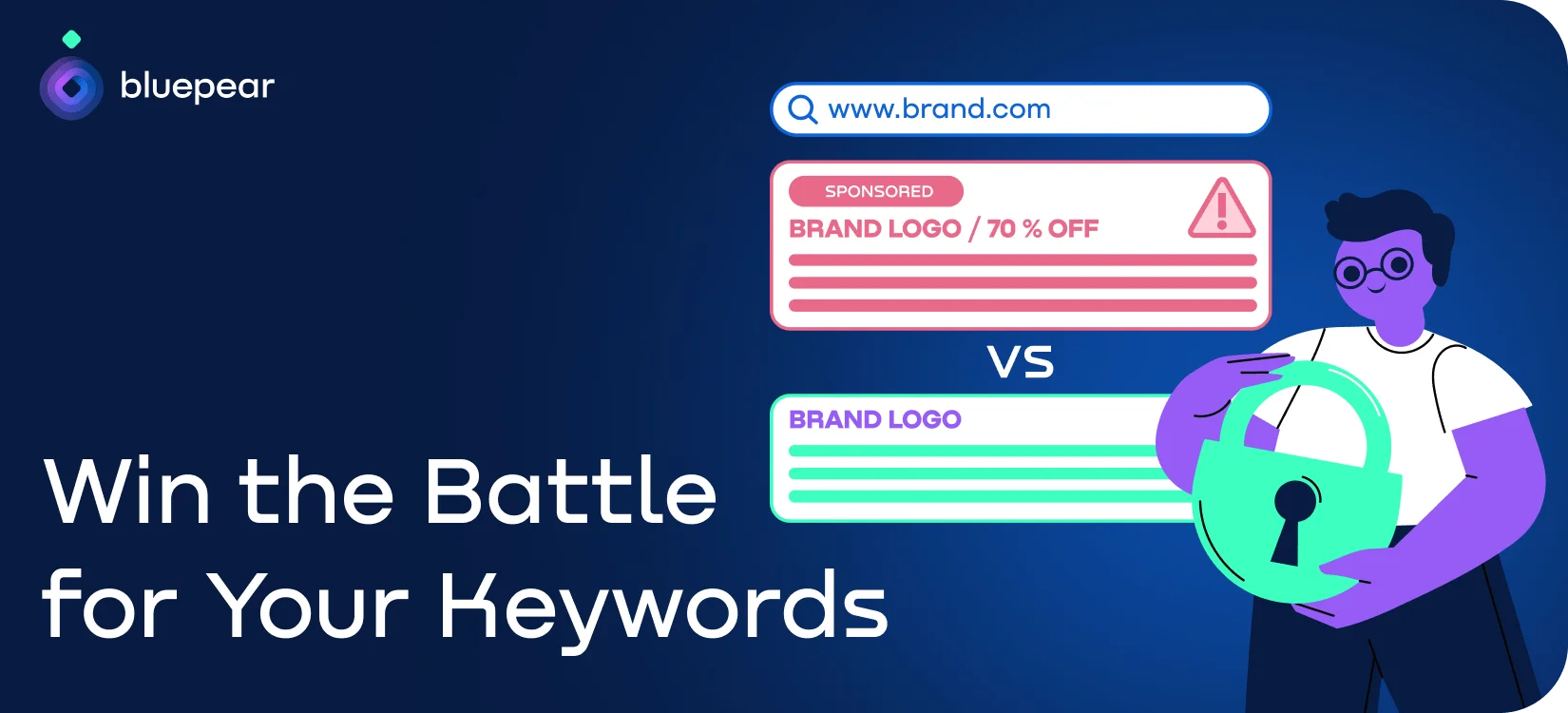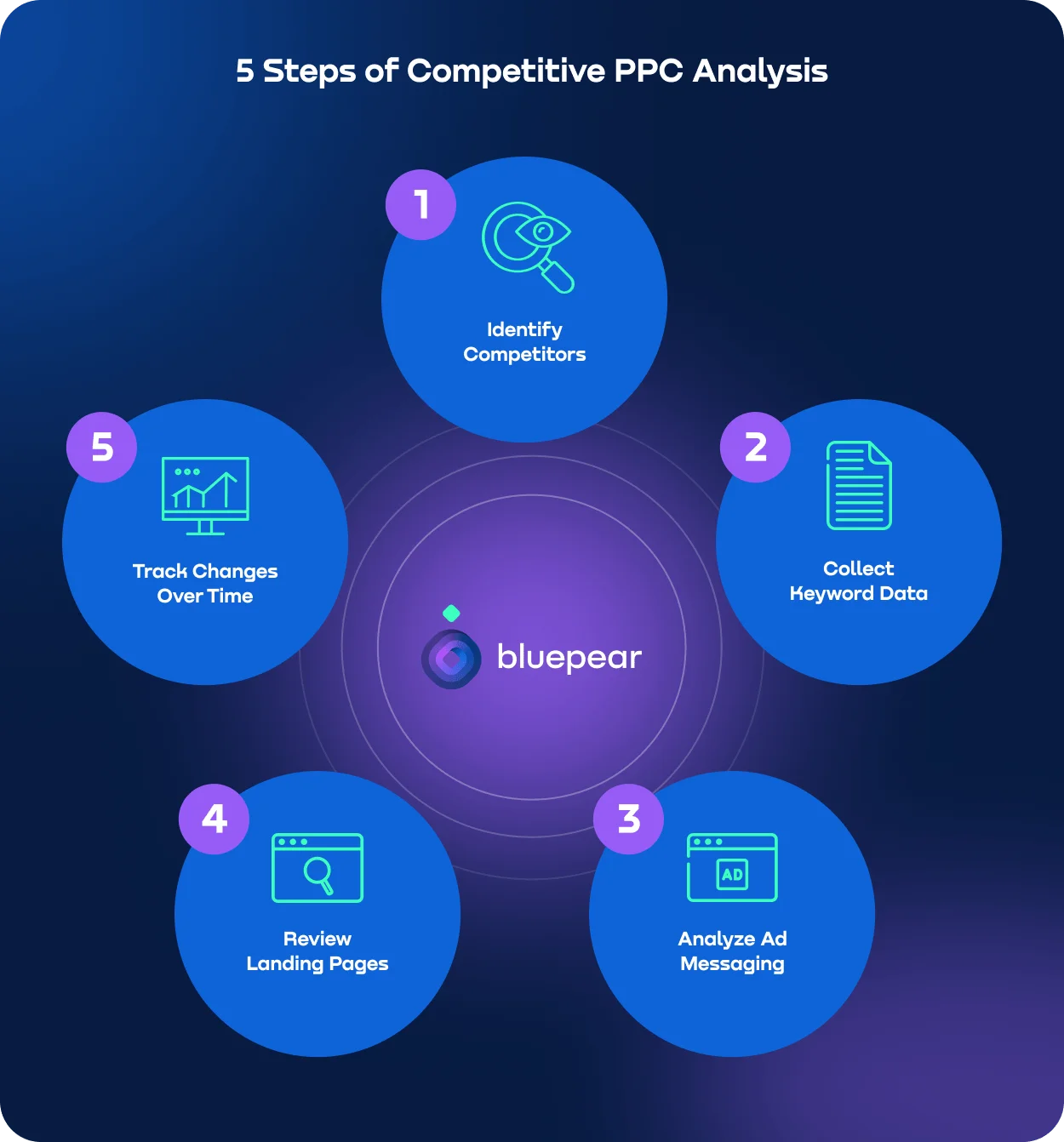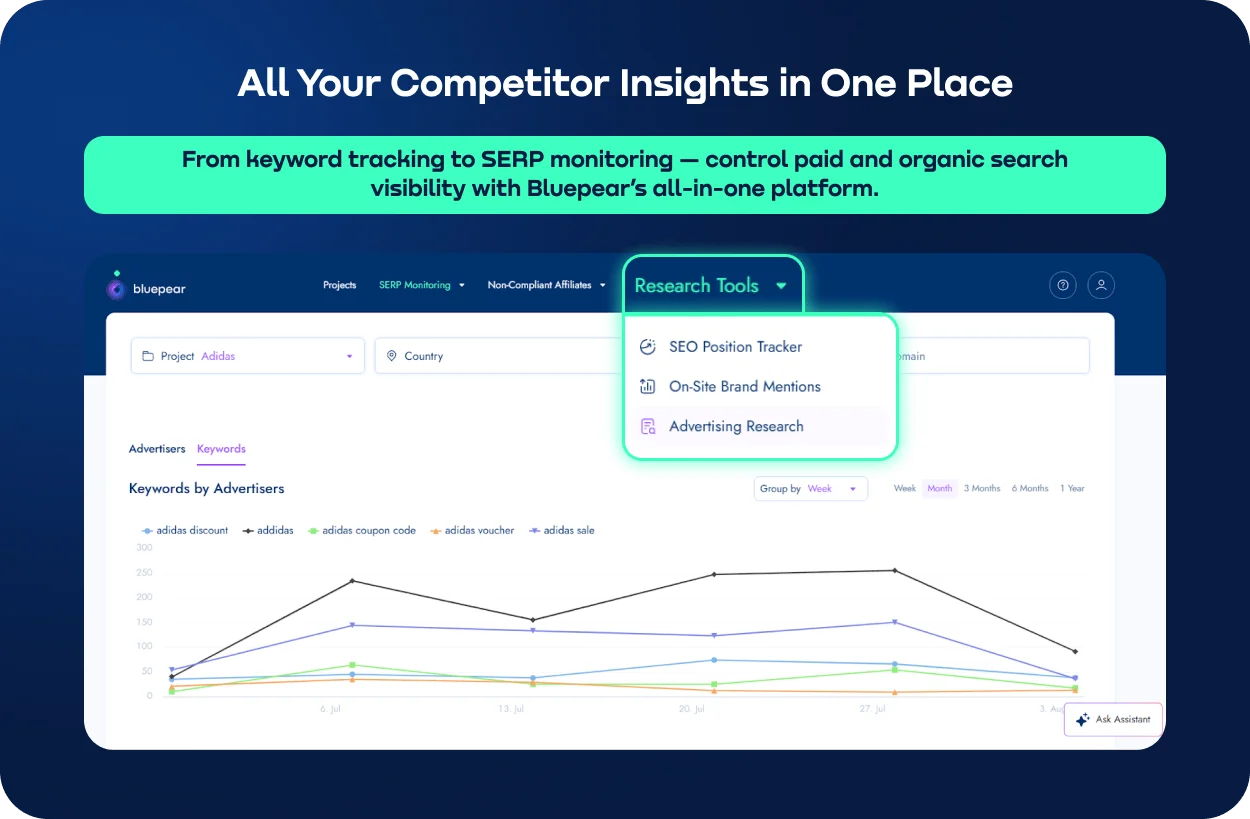
Contents
Competition in search advertising is fiercer than ever. Click prices climb, ad space is crowded, and budgets vanish faster than planned. Every impression counts but so does every missed opportunity.
When you’re not watching closely, competitors can quietly outrank you on critical keywords, hijack your branded searches, and chip away at your market share. It doesn’t happen overnight, but it happens fast enough to hurt your ROI before you even notice.
The numbers underline the importance of competitive PPC analysis:
- • $351 billion projected global search ad spending in 2025, with growing competition pushing CPC rates higher (Amra & Elma).
- • 90% share of internet users reached by Google Ads, meaning your competitors can target almost the same audience you do (Digital Silk).
- • 37% of ad budgets wasted due to poor targeting and much of it preventable with better competitive PPC monitoring and strategic bidding (Ten26 Media).
- • 75% of PPC professionals already use AI-powered automation to gain efficiency and those who lag risk falling behind (Amra & Elma).
Still, there is some good news. Staying ahead doesn’t have to mean sleepless nights and endless manual checks.
In this article, we’ll break down how to build a systematic PPC competitor analysis strategy across PPC and organic search. We’ll explore how PPC analysis tools can help you spot threats early and stretch your ad budget further.
What Is Competitive PPC Analysis?
Competitive PPC analysis means watching what your competitors do in paid search. You track their keywords, ad text, positions, and landing page offers. The goal is to use this knowledge to make better choices for your own ads.
You can do it manually. Manual competitive PPC analysis means checking search results, clicking through ads, and writing down what you see. This works for small campaigns, but it’s slow and easy to miss changes.
Automated PPC competitor analysis requires using professional tools to collect live data. These PPC analysis tools compare trends and send alerts when a competitor makes a move. It saves time and helps you react quickly.
Key areas to watch:
-
• Keywords. See which competitors’ PPC keywords bring them traffic and where you can find untapped opportunities.
-
• Ad copy and CTAs. Notice their wording, tone, and calls to action.
-
• Search positions. Track where their ads appear compared to yours.
-
• Landing page pricing and offers. Check how they use prices, discounts, or guarantees to win clicks.

When done well, PPC competitor analysis gives you a clear picture of the market and keeps you ahead of rivals.
Why Monitoring Competitive PPC Campaigns Matters
Competitors don’t just fight for competitors’ PPC keywords. Many go after branded terms including yours.
When someone searches for your company name, their ad might show up first. This tactic can harm your brand in many ways:
- • Financial losses. You can lose high-intent clicks from users ready to buy, face higher acquisition costs, and pay inflated CPC when forced into bidding wars over your own brand terms.
- • Decline in visibility and CTR. Your brand appears less in top search positions, CTR drops as competing ads take space, and overall engagement weakens.
- • Reputational damage. Competitors hijack your brand message, and potential customers choose rival offers or landing pages instead.
Sounds serious, doesn’t it? Now, let’s see what those threats look like in real life.
Case 1: Aggressive bidding takes your branded clicks
What happened? You were holding the top ad position for your main branded keyword. A competitor started bidding on the same term and increased their bid by 30%. Their ad jumped above yours, capturing attention and clicks from users searching for your brand.
What is the impact? Your CTR dropped because users now saw a competitor’s ad first. Click volume fell, while CPC increased as you had to raise bids to win back the top position. Overall acquisition costs went up, and you were paying more for fewer conversions, while the competitor built awareness using your traffic.
How can automated PPC competitor analysis help? Automated competitive PPC monitoring tools detect when a competitor starts bidding on your branded keywords or increases their bids. You get an alert the same day, allowing you to respond quickly by adjusting your bids or improving ad relevance.
Case 2: Similar offers divert your audience
What happened? You launched a campaign with a 20% discount. A competitor with a similar product copied your offer: same discount, similar copy, and even a comparable ad layout. To users, both ads looked equally relevant.
What is the impact? Some of your audience clicked the competitor’s ad instead. If their landing page loaded faster or looked more appealing, they converted that traffic into sales. Over time, this weakened the uniqueness of your offer and reduced customer loyalty.
How can automated PPC competitor analysis help? Automated tools can spot when competitors start using similar offers or mimic elements of your ads. They track changes in copy, CTAs, and landing pages, enabling you to quickly adapt your campaign. Add a bonus, change the offer, or highlight a unique selling point to stand out in search results. In competitive PPC markets, these shifts can happen in days. A quarterly review is too late. Automated daily PPC analysis helps you spot bid changes, new ads, and updated offers before they start cutting into your traffic and ROI.
Key Elements to Track in Competitive PPC Campaigns
PPC marketing competitor analysis of the right elements is key to outsmarting competitors. Here’s what to watch:
| Element | Why It Matters | How Bluepear Helps |
|---|---|---|
| Keywords | Identify branded and generic terms competitors are bidding on to uncover gaps and threats. | Tracks both branded and generic keywords in real time, highlighting new targets and bid changes. |
| Ad Copy & CTAs | Learn what messages and calls-to-action attract clicks in your niche. | Analyzes competitor ad text and provides side-by-side comparisons for quick insights. |
| Offer Types & Promotions | Spot limited-time discounts, free trials, and special bundles before they steal your traffic. | Logs competitor offers and promotions, with screenshots and date stamps. |
| Landing Pages | Reveal strengths and weaknesses in competitor UX and conversion tactics. | Captures and stores competitor landing pages, tracking changes over time. |
How to Conduct a Competitive PPC Analysis in 5 Steps
Here’s a simple five-step process:
-
1. Identify competitors. Start with those who consistently appear alongside you in search results, both for generic and branded keywords. Don’t forget to include emerging players that may be bidding aggressively.
-
2. Collect keyword data. Use PPC analysis tools to see which terms bring them traffic. Look for gaps. Those are valuable competitors’ PPC keywords they target that you don’t, and ones where you can compete more efficiently.
-
3. Analyze ad messaging. Study their headlines, descriptions, and calls to action. Note the tone, value propositions, and any emotional hooks that might be driving clicks.
-
4. Review landing pages. Click through to see how they present their offer. Pay attention to pricing, promotions, page speed, and design choices that could influence conversions. This is also applicable in case of monitoring affiliates.
-
5. Track changes over time. Set up automated alerts or regular reports. The goal of PPC competitor research is to notice when they adjust bids, refresh copy, or test new offers — and respond quickly.
A good competitive PPC analysis follows a clear structure. It’s not about spying for the sake of it. It’s about gathering the right data and using it to improve your own campaigns.
Automating PPC Competitor Analysis With Bluepear
Manual analysis is no longer enough. Checking search results once a week or reviewing campaigns quarterly leaves huge blind spots.
Your rivals can change bids, ad copy, or competitors’ PPC keywords in a matter of hours. By the time you notice, they may have already taken clicks, raised your CPC, and captured part of your audience. Manual PPC marketing competitor analysis is also resource-heavy. It’s slow to run, incomplete in scope, and takes a lot of time from your marketing team.
Bluepear closes these gaps with full automation:
- • 24/7 monitoring ensures you detect competitor moves (bid increases, new ad launches, landing page changes) the moment they happen, not weeks later, so you can react before they gain an advantage.
- • Residential IPs allow you to see the exact ads your target audience sees in different locations, avoiding “clean” or filtered results that miss competitor campaigns.
- • Multiple user agents reveal how competitors adapt their ads for desktop, mobile, and different browsers, giving you a complete picture of their creative strategy.
- • Evidence collection keeps a record of competitor ads, landing pages, and redirect flows, so you can analyze their tactics over time and prove changes internally or to stakeholders.
For PPC competitor research specifically, Bluepear delivers:
- • Branded keyword monitoring detects when competitors bid on your brand terms and shows their ad variations.
- • Ad copy tracking captures and compares headlines, descriptions, and CTAs to reveal messaging shifts.
- • Position tracking records ranking changes over time, highlighting aggressive bidding or new players entering the market.

By automating PPC competitor research, you react in hours instead of weeks, protect high-intent traffic, and make smarter bidding decisions. This not only prevents wasted ad spend but also ensures your campaigns remain competitive without consuming your team’s time.
Turn Competitive PPC Insights Into Winning Campaign
Collecting competitor data is only the first step — the real value comes from turning those insights into action. Here’s how to use what you learn to strengthen your own PPC performance.
- • Use untapped competitors’ PPC keywords. When PPC marketing competitor analysis reveals terms with low competition and solid search volume, you can target them to gain clicks at a lower CPC. These “hidden” opportunities often deliver strong ROI while avoiding direct bidding wars.
- • Protect your brand from traffic hijacking. If PPC marketing competitor analysis shows someone is bidding on your branded keywords, respond quickly by strengthening your bids, improving ad relevance, or launching brand-specific campaigns. This ensures high-intent searches lead to you, not your rivals.
- • Continuously optimize bids and creatives. Competitor activity changes fast. Use their shifts in pricing, messaging, or offers as triggers to adjust your own bids and refresh ad copy. PPC competitor research and regular updates help maintain visibility, keep CTR high, and prevent competitors from gaining an edge.
By acting on competitor insights in real time, you turn monitoring into a competitive advantage.
Final Thoughts on Competitive PPC Analysis
The PPC landscape shifts every day. Competitors are constantly testing new approaches, scaling what works, and targeting the keywords that bring you the most valuable traffic. Without consistent visibility into their actions, small changes on their side can turn into big losses for you.
Automation is the key to staying ahead. With the right PPC analysis tools, you can monitor competitor moves in real time, react before they gain ground, and protect both your market share and your ad budget.
FAQ
What is competitive PPC analysis?
It’s the process of tracking competitors’ ads, keywords, bids, and landing pages to improve your own campaign strategy.
How often should I monitor competitors’ ads?
Ideally 24/7. Bids, competitors’ PPC keywords, and offers can change within hours, so automated monitoring ensures you never miss a move.
Can I track competitor keyword strategies?
Yes, PPC analysis tools like Bluepear show the branded and generic terms your competitors bid on.
Does Bluepear detect hidden or cloaked ads?
Yes, by using residential IPs and multiple user agents to see ads exactly as different audiences see them.
Can PPC competitor analysis help reduce ad spend?
Yes, by avoiding wasted bids, finding low-competition keywords, and reacting quickly to competitive threats.

